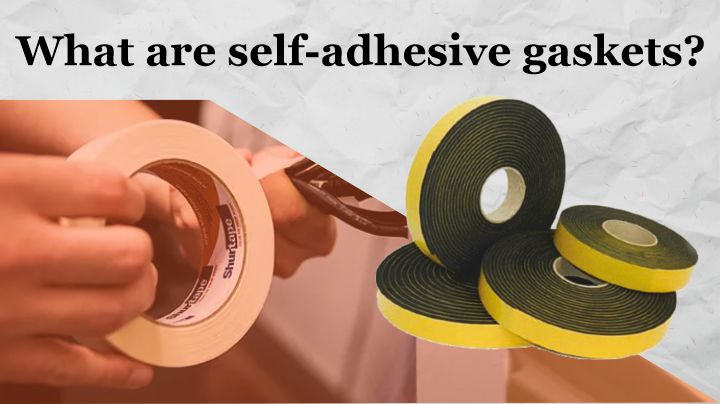
For a variety of industries and operating situations, Elettro manufactures self-adhesive gaskets and adhesive gasket materials. Please do not hesitate to contact us on +91-9714597995 if you require technical assistance in selecting the appropriate gasket and adhesive for your application. The information below is a broad overview of self-adhesive backed gaskets.
What are Self-Adhesive Gaskets?
Gaskets having an adhesive backing are referred to as self-adhesive gaskets. Release paper safeguards the adhesive by covering it and keeping it intact until it's time to utilize it. The release paper is ripped off and the gasket is fastened to the surface where it is being placed when it comes time to install it. Rather than performing any structural or sealing function, the glue is typically used as a fitting or installation aid.
The advantage of self-adhesive is that it allows gaskets to be applied in a much cleaner and more efficient manner than they would be if they were not affixed to the surface or if glue was added during the installation process.
Why not use a Self-Adhesive Gasket?
Self-adhesive gaskets are typically used where there is a risk of the gasket slipping or deforming while being installed. Adhesives are also employed in locations where time is a constraint (such as in mining or subsea operations), as gaskets must be installed quickly for safety reasons. As a result, self-adhesives are commonly employed to help keep the gasket in place until the flange bolts are adequately tightened, preventing the gasket from slipping or deforming during the sealing process.
Adhesive-backed gaskets are also utilized on removable panels (such as in electrical switchgear cabinets) where a gasket is required to boost the cabinet's IP rating. This permits the panel to be rapidly removed for inspection, whereas removing the gasket individually would be time-consuming and unsafe.
Can I use a Self-Adhesive Gasket?
If you believe your application requires an adhesive gasket, the working environment (including temperature, pressure, and chemical resistance) and the nature of the surface to which you want to glue the gasket will determine whether you can use a self-adhesive gasket. Dust and chemicals (such as solvents) that could prevent the adhesive from working correctly must normally be removed from the mating surfaces.
We can assist you to specify a gasket material and adhesive that is appropriate for your application after we know the environment and operation conditions in which the gasket and adhesive will be used.
What adhesives are available?
Gasket materials can adhere to a variety of surfaces with a variety of adhesives (including 3M VHB). Hot-melt and acrylic-based adhesives are the most common. A mild tack from hot-melt glue will help hold a gasket in place, but its tackiness will wear off with time. Acrylic-based adhesives, on the other hand, can be moved and relocated once they've been installed because they don't reach maximum strength for several hours.
It's also possible that the type of release paper used with the glue makes a difference. Tissue carriers, for example, provide flexibility, whereas shim carriers aid in dimensional stability. Scrim carriers enable less strain and a single adhesive layer to be applied.
How long do Adhesive Gaskets last?
Gaskets have a living adhesive backing that will dry out over time. Because the majority of adhesive-backed seals work solely on a tack (no chemical change occurs), they have a limited shelf-life. Although various factors, such as transportation and storage conditions, can alter this, these gaskets should be used within six months after purchase.
The adhesive will only last a limited period of time once the gasket is in place for similar reasons. (Keep in mind that gaskets are usually backed with adhesive to aid in fitting rather than to serve any other purpose.) When fitting, a two-part adhesive can be used if you need the glue to last for a longer period of time.
Effects on Resistance, Pressure, Chemical Resistance, and Performance.
The function of a gasket should not be harmed by the adhesive. However, there are a few points to keep in mind: adhesives have little effect on a gasket's pressure rating, but the same cannot be said for temperature and chemical resistance.
Ordinary adhesives only work at temperatures between 50 and 60 degrees Celsius. If your working environment is hotter, you'll need a high-temperature acrylic adhesive that can withstand temperatures ranging from -30°C to +160°C. Chemical resistance is minimal or non-existent in adhesives. If specified chemical resistance is a requirement of your specification, an adhesive is unlikely to be used.
Limitations of Self-Adhesive Gasket Tape
Any type of gasket material, including solid and foam rubbers, can be adhered to using adhesive backing (such as neoprene, nitrile, EPDM, and Viton). Because silicone rubber is such an inert material, it is difficult to use an adhesive on it. PTFE is similarly inert, requiring scouring (roughening one of the surfaces) before adhesive backing may be placed.
In which industries are Adhesive-Backed Gaskets commonly used?
In various sectors, self-adhesive seals are used. Door seals, lid seals, gaskets surrounding windows, and electronic equipment displays are all common uses. Adhesive gaskets are widely utilized in the electronics industry ( for example, in LCD screens). Gaskets are used internally by machine manufacturers, such as injection molders and milling machines, to execute various operations ( mounting, etc.). These gaskets are usually adhered to the surface with glue to keep them in place.
Self-adhesive is used on some extremely large gaskets to make them simpler to maintain in place while the flange bolts are tightened.
